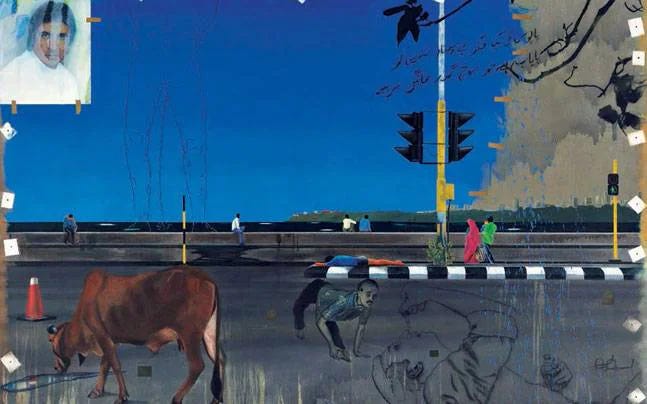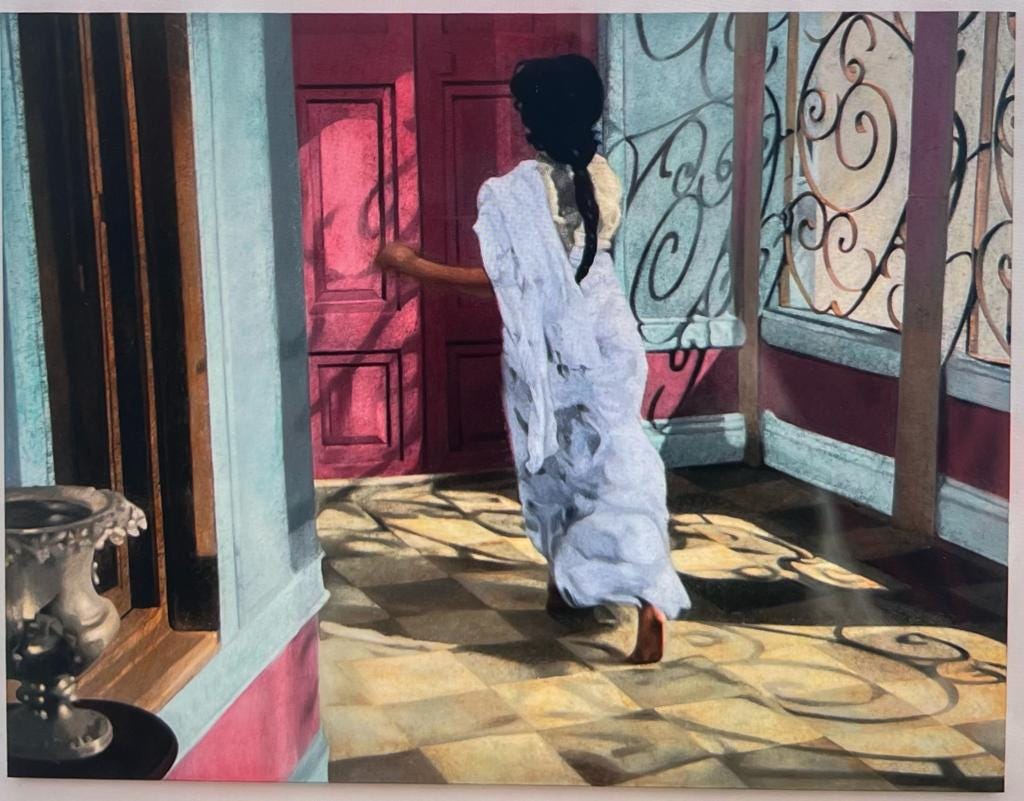A Memory of Memories
Atul Dodiya is in the house
I remember how completely fascinated (and mystified) I was when I first saw Atul Dodiya’s ‘Sunday Morning on Marine Drive’ some two decades back. It was in the office I worked in, which was a veritable art gallery, and, ever so often I used to stand in front of it, trying to prise out meanings. A colleague and I would swap thoughts, and some of them were quite scatalogical - what with a giant man pissing into the sea and another taking nasal drops!
As luck would have it, I got to meet Atul very briefly in Jehangir, in course of an exhibition my company was sponsoring, and I immediately asked him about this painting. He laughed and said “Firstly, did you like it?”I said “Oh yes, but I want to know what you had in mind when you painted it!” And he did, at length, the humble gentleman that he is.
After all these years, this is what I remember him telling me. He talked about how Mumbai was in his blood, and Marine Drive with its iconic view of Walkeshwar was what symbolized the city for him. And each image was a part of this city. The glamour, the lovers, the cripples, the migrants, the ubiquitous cow. All nameless. And then there is Amitabh. And, there is M.F. Husain's handwriting etching urdu couplets by Faiz Ahmed Faiz. And the person taking nasal drops is Atul himself, allergic sometimes to the city, but sustaining himself without ever thinking of leaving it!
In ONE painting, a multitude of tales and references, at the same time maintaining, as it did, a pulchritude and integrity of consummate art. For me, this was true art - not just of facile beauty, but with meaning stitched into every stroke of it.
And then I encountered Dodiya’s incredible series of imaginary conversations which a young boy called Bako was having with Bapu, Gandhiji. The series was called ‘Bako exists. Imagine’ and consisted of twelve paintings and an installation. These text-inspired paintings were based on a Gujarati story by poet Labhshanker Thaker. Bako is a young boy who meets Bapu - Mahatma Gandhi, in his sleep, and they start talking to each other. They joke, swap feelings, pull each other’s legs - but subtly there are myriad messages of wise Bapu for the young Bako. The series was exceptional in its delineation of how learning, when made playful, could enrich both the teacher and the taught.
I give just one work from the series -
You can find the other paintings in the series here.
Now here’s the superb news. There’s a brand new series Dodiya has painted. Let the website of Gallery Chemould speak of the genesis and philosophy of these paintings -
Drawing from popular Indian cinema, Atul Dodiya creates paintings populated by iconic characters in his signature realistic style. This is not the first time Dodiya has painted from cinema, and in this latest series Dr. Banerjee in Dr. Kulkarni's Nursing Home and Other Paintings 2020-2022, he returns to the theme in a reel of 24 paintings.
24 is a particular number in cinematography, with 24 frames in each second. In this show, we see 24 paintings mimicking a running storyboard, creating their own fiction.
Watching and rewatching movies during the lockdown year of the pandemic triggered the series. Films like Padosan, Kapurush, Kagaz ke Phool, Awaara, Ittefaq, that he watched often with his parents as a young man, and one like Anand (from which the title of the exhibition emerges), where then superstar Rajesh Khanna paved the way for Amitabh Bachchan, all find a way into the work. In 2021, Dodiya had returned to Khanna as a protagonist for a private commission. Earlier Rajesh Khanna had played a larger than life hero in Dodiya’s school years when he would charm his 5 sisters’ girl-friends with his deft drawings of the superstar. Now, as Dodiya returns to cinema in this series of paintings, he returns to painting his sisters’ heartthrob.
Dodiya’s references to cinema go back as early as 1995 when he used images from the films of Andrei Tarkovsky, Ritwik Ghatak and Guru Dutt. Here, he looks closely at film sets from a range of popular and non-commercial cinema, from filmmakers like Hrishikesh Mukherjee to Satyajit Ray. The false character of sets – the fake staircase, a painted window, or a door that leads to nowhere; provide the vocabulary for this set of paintings. Dodiya looked at props – lamps, vases, telephones, photo frames, art deco furniture, faux antiques, or flooring that might have been laid over by paper to create a black and white grid.
While watching these films as closely as he did, Dodiya began to photograph his own decisive moment. Each of these “frozen moments”, carefully chosen, shot on his iPhone – sometimes depicting the back of the actor, at times walking from one room into another, or a bending woman reaching for something in a drawer, all became pictorial possibilities with the subjects imbued with a new mystery.
The false interiors are celebrated, recreated in the pastel hues of the hand painted photograph of the early 20th century. The pinks, turquoise, pale blues gather to build a tonal atmosphere where the unreal becomes a new story, another truth.
Here go some of the paintings -
Surekha Pandit as Aruna in Anupama, 1966, Director Hrishikesh Mukherjee
Leela Naidu as Anuradha in Anuradha, 1960, Director Hrishikesh Mukherjee
Surekha Pandit as Aruna in Anupama, 1966, Director Hrishikesh Mukherjee
Saira Banu as Bindu in Padosan, 1968, Director Jyoti Swaroop
Jean-Pierre Léaud as Paul in Mascullin Féminin, 1966, Director Jean-Luc Godard
Balraj Sahni as Dr. Nirmal Choudhary and Leela Naidu as Anuradha in Anuradha, 1960, Director Hrishikesh Mukherjee
Sharmila Tagore as Uma in Anupama, 1966, Director Hrishikesh Mukherjee
Madhabi Mukherjee as Karuna in Kapurush 1965, Director Satyajit Ray
Just see the colour template, the shades, which evoke such tremendous nostalgia. Even as each painting captures only a moment, there’s still an evocation of a sense of timelessness. If we know the film, it is a journey back in time, to the feelings the scenes evoked in us all those years back. The gorgeous chiaroscuro, the vignettes on the edge, the emphasis on painting the characters from the back, all seem to give the effect of someone in the room, observing everything in great detail, but with empathy and understanding. There is a lot of heart and tenderness with which these paintings have got created - as if the artist knew these had to be delicately done, else something should break - yet again.
See all the paintings here.
Discover more of and on Atul Dodiya -
A quick guide to his life and times -
The influence of a city on an artist -
His influences in his own words -
A lovely interview -










